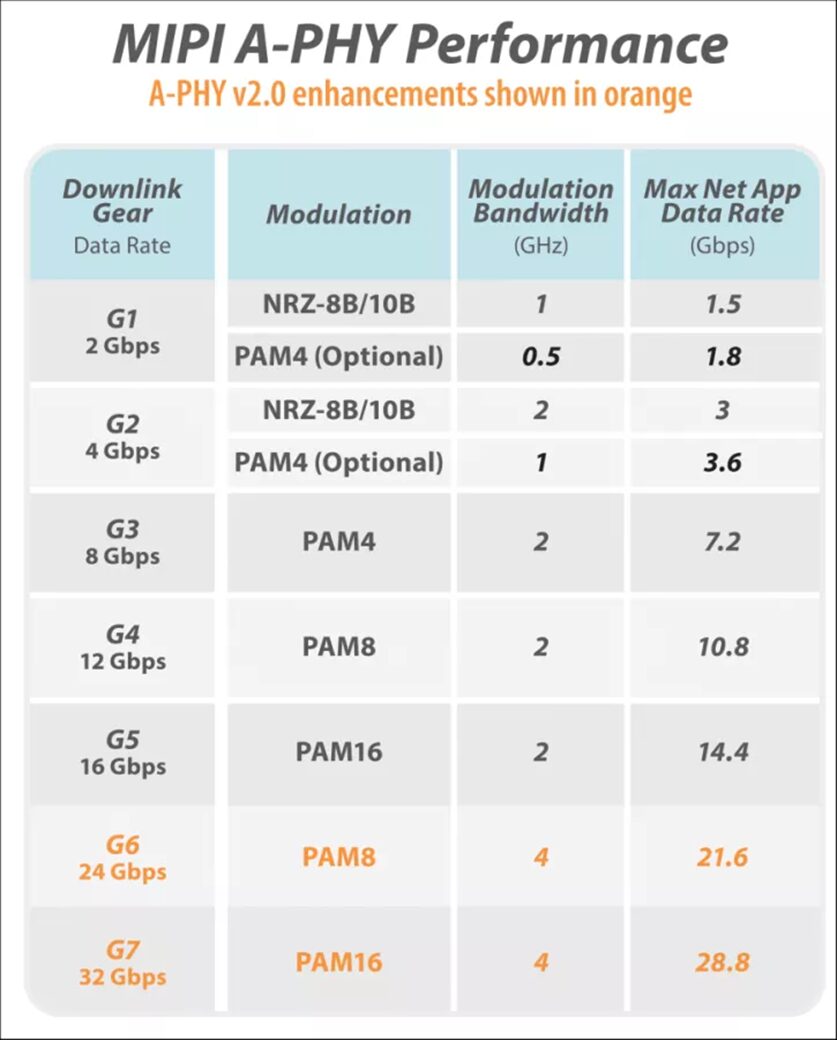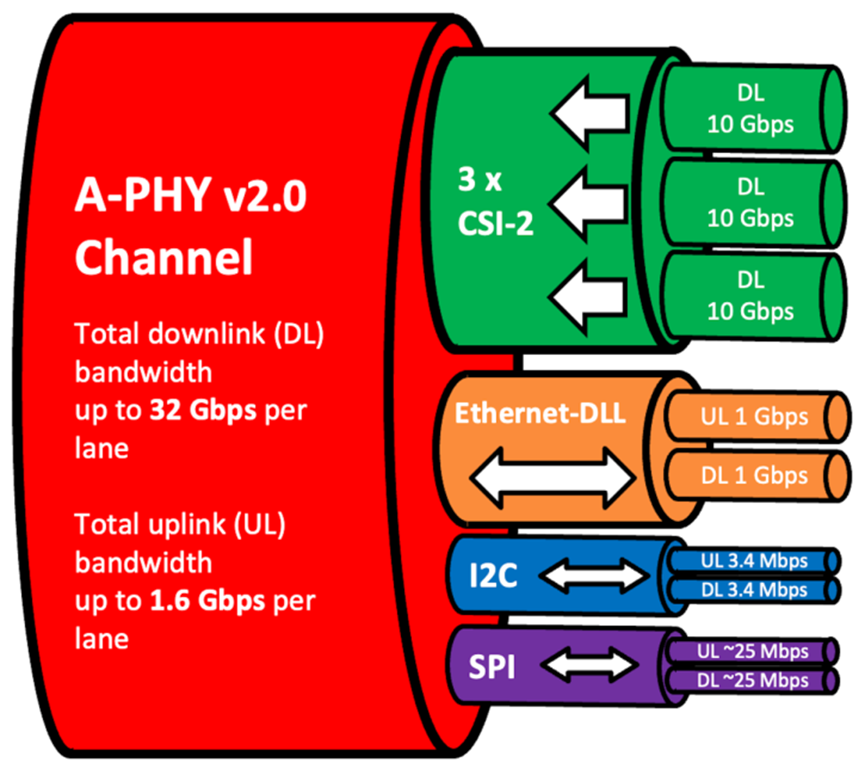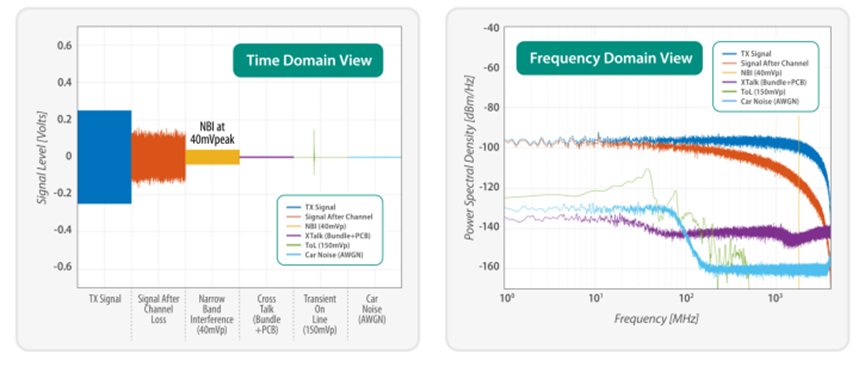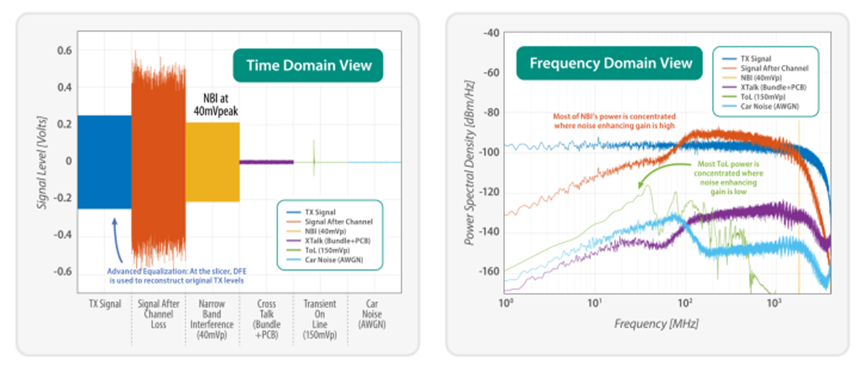
Click the blue words to follow us

The development of Advanced Driver-Assistance Systems (ADAS), digital cockpits, infotainment systems, and autonomous driving systems has led to an increasing use of cameras, sensors, and displays in vehicles. To effectively control electromagnetic interference in these systems, the MIPI Alliance developed the A-PHY standard.
MIPI A-PHY allows for asymmetric data connections for automotive applications that require high data throughput. At the same time, it helps to control electromagnetic interference issues within a certain range.
With the continuous increase in resolution, frame rate, and bit depth, the multi-gigabit throughput required for connecting cameras, sensors, and displays in vehicles presents particular challenges for design. This necessitates the development of new electronic/electrical (E/E) architectures that employ safety-critical, long-distance, high-speed interfaces.
To support these new developments, the MIPI Alliance developed A-PHY (also recognized as IEEE 2977-2021 standard), which is a long-distance, high-speed, asymmetric serial interface used to connect cameras, sensors, and displays via MIPI CSI-2, MIPI DSI-2, DisplayPort, and other industry standard protocols. A-PHY eliminates the need for proprietary physical layers (PHY) and bridges, simplifies the in-vehicle network, and reduces costs, weight, and development time.
Future automotive architectures will include A-PHY interfaces to complement symmetric interfaces like in-vehicle Ethernet. Unlike other interfaces, MIPI A-PHY is designed to address the unique challenges of electromagnetic interference in automotive environments.

Table 1: Improvements in Downlink Performance of MIPI A-PHY v2.0 Compared to Previous Versions (Image Source: MIPI Alliance)
01
Overview of MIPI A-PHY
A-PHY enables asymmetric data connections in point-to-point, daisy chain, and other topologies, allowing high-speed unidirectional data, integrated bidirectional control data, and optional power to be transmitted via a single cable, thereby saving on cabling, costs, and weight. It provides transmission distances of up to 15 meters (including four inline connectors), low latency (e.g., 6µs at 16 Gbps), supports various cable types (coaxial cables, shielded differential pairs, and star quad cables), and a variety of cable power options. A-PHY is optimized for sensor integration, designed to be simple with lower baud rates, suitable for most process nodes.
A-PHY v1.1.1 supports data rates of up to 16 Gbps per channel, reaching 32 Gbps through a single cable (i.e., using a star quad cable with dual downlinks). The upcoming A-PHY v2.0, scheduled for release in Q3 2024, will enhance data rate support to 32 Gbps per channel, achieving up to 64 Gbps through a single cable. A-PHY exhibits an extremely low packet error rate ( <10^-19) throughout the vehicle’s lifespan, providing exceptional noise immunity and reliability. To optimally enhance the interface, A-PHY can use a Protocol Adaptation Layer (PAL) to simultaneously transmit multiple high-level protocols, with these PALs supporting native coupling with MIPI CSI-2 (for cameras) and MIPI DSI-2/DisplayPort/Embedded DisplayPort (for displays). Additionally, other PALs support I2C, GPIO, Ethernet, SPI, audio, and MIPI I3C interfaces (Figure 1).

Figure 1: Functional Description of A-PHY v2.0 Channel
(Image Source: MIPI Alliance)
02
High Demand for High-Speed Interfaces
In addition to the reduced signal-to-noise ratio, the electromagnetic environment within motor vehicles must also be considered. Key factors include narrowband interference, transient interference, alien crosstalk, and additive white Gaussian noise in the vehicle environment. The illustration in Figure 2 shows the time and frequency domain graphs on the receiving pad when transmitting through the channel at a symbol rate of 4 GBaud and a peak-to-peak voltage of 500 mVpp. The channel experiences approximately 20 dB of attenuation at its 2 GHz Nyquist frequency. The deep blue represents the transmitted signal, while the orange represents the signal after channel loss.

Figure 2: TX and Other Signals on the Receiver Connector
(Image Source: MIPI Alliance)
Figure 3 shows the performance of these signals on the receiving slicer after adding analog front-end (AFE) and feed-forward equalizer (FFE) gain. Even with relatively complex equalization and filtering techniques, only about 15 dB of noise gain is allowed, and the effects of narrowband interference (NBI) are still visible relative to the expected reconstructed transmit level. In the frequency domain, this is because most of the NBI power is concentrated at frequencies where the equalizer noise amplification effects are higher. In contrast, transient interference (ToL) noise occurs at lower frequencies where the noise gain is much lower.

Figure 3: Signals on the Receiver Slicer (after AFE + FFE amplification) (Image Source: MIPI Alliance)
03
Automotive Electromagnetic Compatibility MIPI A-PHY
—Designed to Operate in Harsh, High Electromagnetic Interference
Environments
This brief analysis indicates that high-speed automotive links are affected by electromagnetic interference, necessitating noise suppression and error correction mechanisms to counteract the negative effects of automotive electromagnetic interference, ensuring the safe and stable operation of multi-gigabit data links.
To mitigate the effects of cable aging, the MIPI A-PHY interface is designed to provide at least 40mV of near-end crosstalk (NBI) peak noise immunity at the receiving pad. To achieve this, A-PHY employs the following technologies:
■ A dynamic pulse amplitude modulation scheme for all speed grades from non-return-to-zero 8b/10b to Pulse Amplitude Modulation 16 (PAM16). This modulation scheme can dynamically adjust the pulse amplitude based on the signal transmission requirements, enhancing the signal’s immunity to interference and transmission efficiency.
■ A real-time canceller that provides over 36dB of real-time near-end crosstalk (NBI) cancellation capability. This canceller can monitor and eliminate near-end crosstalk in the signal in real time, ensuring the clarity and accuracy of the signal.
■ A dynamic retransmission mechanism with a packet error rate of less than 10^-19, equivalent to an average interval time of over 10,000 years. This means that over an extremely long period (with an average interval of over 10,000 years), the transmission error rate of packets is extremely low and nearly negligible. This mechanism ensures that packets can be accurately and reliably delivered to the receiving end by dynamically adjusting retransmission parameters during transmission.
In contrast, other interface technologies assume a maximum near-end crosstalk (NBI) of about 6mV and rely solely on forward error correction (FEC) mechanisms, which are often insufficient to ensure the safe and reliable operation of the interface.
04
Conclusion
MIPI A-PHY is an open industry standard with strong ecosystem support, covering development, testing, and interoperability, with a clear path to commercialization. Unlike other interfaces, A-PHY has high noise immunity, enabling particularly reliable high-speed data transmission throughout the vehicle’s lifespan using current-generation copper cables. Additionally, a reference compliance test suite has been developed, and a compliance program is being introduced to verify whether A-PHY devices meet specifications.
About Valens
Provider of semiconductor products

Valens Semiconductor (NYSE: VLN) is a leader in high-performance connectivity, dedicated to helping customers transform the digital experiences of users globally. Valens’ chipsets are integrated into the devices of many well-known customers, supporting advanced audio-visual installations, next-generation video conferencing, and advancing ADAS and autonomous driving technologies. Valens continually pushes the boundaries of connectivity technology, establishing standards across its operational fields, with its technology forming the basis of industry-leading standards such as HDBaseT® and MIPI A-PHY.


Click “Read the original text” to visit Valens’ official website
